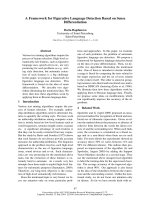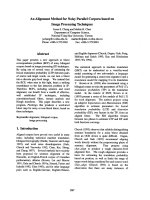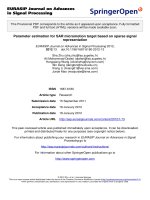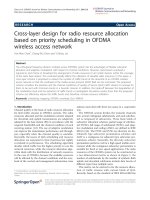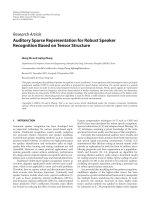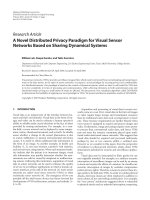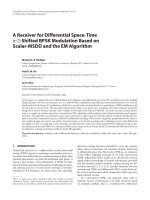Prognostics for tool condition monitoring based on long term and short term prognostic approaches 2
Bạn đang xem bản rút gọn của tài liệu. Xem và tải ngay bản đầy đủ của tài liệu tại đây (3.03 MB, 162 trang )
ii
National University of Singapore
NUS
Acknowledgements
I want to express my most sincere gratitude to my supervisors, Associate
Professor Hong Geok Soon and Professor Wong Yoke San. I want to thank them for
their motivation, support, and critique about the work. Their depth of knowledge,
insight and untiring work ethic has been and will continue to be a source of
inspiration to me.
Thanks to Mr.Simon Tan, and all the technicians at Advanced Manufacturing
Lab of NUS for their kind and quick technical assistance during my experiments.
I have also benefitted from discussion with many of seniors and colleagues. In
particular Dr.Kommisetti V R S Manyam, Dr. Yu Deping, Ms. Wang Qing, Dr. Wu
Jiayun and others in the Control and Mechatronics Lab.
I also would like to thank National University of Singapore for offering me
research scholarship and research facilities. I benefitted from the abundant
professional books and technical Journal collection at NUS library.
Finally, I would like to devote the thesis to my family for their love and
understanding.
iii
National University of Singapore
NUS
Table of Content
Acknowledgements ii
Table of Content iii
Summary vii
List of Table ix
List of Figures xi
List of Symbols xiv
Nomenclature xv
Chapter 1 Introduction 1
1.1 Tool Condition Monitoring 1
1.2 Motivation and Challenges 3
1.3 Objectives 5
1.4 Organization of the Thesis 6
Chapter 2 Literature Review 9
2.1 TCM Review 9
2.1.1 Background 9
2.1.2 Overview of Tool Condition Monitoring 12
iv
National University of Singapore
NUS
2.2 Prognostic Methodologies for General Health Monitoring Review 15
2.2.1 Reliability Analysis 16
2.2.2 Condition Monitoring Based Prognostic 18
2.3 Review for TCM Prognostics and its Challenge 23
Chapter 3 Long-term Prognostics 29
3.1 Introduction 29
3.2 The Feasibility of Using VDHMM to Model the Machining Process . 32
3.2.1 HMM Based Prognostics 34
3.2.2 Modeling the tool wear as stationary Markov process and Markov
process with explicit state duration. 37
3.2.3 VDHMM parameter estimation 42
3.2.4 Case study results and discussion 53
3.3 Adaptive VDHMM based prognostics 65
3.3.1 Adaptive VDHMM Fundamentals 66
3.3.2 Experimental setup 72
3.3.3 Results and discussion 73
3.4 Adaptive-VDHMM based feature selections for different number of
states 81
v
National University of Singapore
NUS
3.4.1 Feature extraction methodology 83
3.4.2 Results and discussion 87
3.5 Conclusion 94
Chapter 4 Short-term Prognostics 99
4.1 Introduction 99
4.2 Theoretical background 104
4.2.1 Delay Coordinate Embedding 104
4.2.2 Function Approximation Methodologies 105
4.2.3 Bayesian MLP for regression 108
4.3 Results and discussion 109
4.3.1 Force prediction 109
4.4 Combination of Short term and long term prognostics 118
4.5 Conclusions 121
Chapter 5 Conclusions and Future Work 123
5.1 Conclusions and Contributions 123
5.2 Conclusions 123
5.3 Contributions 124
vi
National University of Singapore
NUS
5.4 Future work 126
5.4.1 Variable cutting condition study for long-term prognostics 126
5.4.2 Study the signal properties for short-term prognostics 127
References 128
vii
National University of Singapore
NUS
Summary
Tool condition monitoring (TCM) plays an important role in modern
manufacturing system. At present, the researches in TCM focus mainly on
diagnostics of different tool conditions. Such detection approaches may sometime be
too late in avoiding damage or quality issues associated with the worn or broken tool.
Hence, this thesis proposes a TCM prognostic system which aims to enable a future
scheduling decision as well as optimal tool replacement time.
The proposed TCM prognostic system consists of two parts: long term
prognostics, and short term prognostics. In the long term prognostics, the remaining
useful life (RUL) is prognosticated by utilizing variable duration Hidden Markov
model (VDHMM). VDHMM overcomes the state duration limitation of the
traditional HMM. The relation between the model structure and the tool wear process
is studied to understand and address issues regarding the factors that affect the
prognostic results. It is found that VDHMM with Gaussian distribution as the state
duration offers effective prognosis for the machining conditions studied.
Several features have been derived from the force signal captured during the
machining process and identified to correlate with tool conditions. As appropriate
selection of these features affects the prognostic results, a feature selection method is
proposed. The method identifies and selects a sub-set of complementary and
supportive features. The proposed method is compared with the feature ranking
methods, which rank the features based on their relevance with tool wear progress.
viii
National University of Singapore
NUS
The result shows that features considered relevant to tool wear may worsen the
prognostic results, while those considered not relevant to tool wear could improve the
prognostic results, when the latter features complement and support other features.
Arising from variations in material characteristics of the workpiece and tool,
there might be unexpected or pre-matured tool wear occurring before the failure time
expected from the long-term prognostics. Hence, a short term prognostics capturing
the short term dynamics of the tool wear is proposed. This is achieved by adding a
cutting force prediction part to a diagnostic system. Different cutting force prediction
structures are analyzed. It is found that Sauer’s local linear model can achieve
reasonable prediction accuracy and the shortest computation time.
ix
National University of Singapore
NUS
List of Table
Table 3.1 Experimental conditions and equipment 53
Table 3.2 The tool wear table 57
Table 3.3 The A-D test for the 8 samples 60
Table 3.4 The residual lives take each state as the initial state of the 8 life tests 61
Table 3.5 The natural mean residual life 61
Table 3.6 Cutting conditions 73
Table 3.7 average model for the training sets 74
Table 3.8 the transformation matrix for the training sets 74
Table 3.9 The MAPE of MRL taking each state as the initial. 78
Table 3.10 The cross validation 81
Table 3.11 Summary of features 87
Table 3.12 The feature sets selected by the proposed method 90
Table 3.13 feature selection by LDA 91
Table 4.1 The smallest embedding dimension for all the test and their average 110
Table 4.2 Compare the ASIE and calculation time for Sauer’s local linear
approach, Global linear approach and non-linear (MLP) approach 112
x
National University of Singapore
NUS
Table 4.3 Selected features 113
Table 4.4 Successful rate for each testing sets. 115
Table 4.5 Two prognostic scenarios 118
Table_Apx A-1Cutting condition 142
xi
National University of Singapore
NUS
List of Figures
Figure 2.1 Tool wear definition 9
Figure 2.2 Tool wear measurement. 10
Figure 2.3 TCM process 13
Figure 3.1 The on-line prognostic process for a target test at time t. 37
Figure 3.2 a left-to-write Markov process 39
Figure 3.3 A Markov process with the explicit state duration distribution 40
Figure 3.4 the feature 1 & 2 and its GMM model for fresh, moderately worn and
worn tool. 45
Figure 3.5 feature 9 & 10 and its GMM model for fresh, moderately worn and
worn tool 45
Figure 3.6 The probability of features vectors belongs to fresh, moderately worn
and worn tools. 46
Figure 3.7 different combinatiosn of k0 and λ0 and their corresponding log-
likelihood. 52
Figure 3.8 experimental setup 54
Figure 3.9 Geometry of a face milling operation 54
Figure 3.10 Cutting force sample for fresh cutting tool 55
xii
National University of Singapore
NUS
Figure 3.11 Cutting force sample for worn cutting tool 55
Figure 3.12 normalized maximum resultant force per revolution 56
Figure 3.13 normalized average resultant force per revolution 56
Figure 3.14 Eight life tests under the same cutting condition for testing the state
duration distribution type. 57
Figure 3.15 The natural MRL compared with the MRL estimated by
Conventional HMM (Exponential), VDHMM with Gaussian and Weibull
distributions 63
Figure 3.16 the state duration mean changes with the number of training set
changes 64
Figure 3.17 VDHMM-based adaptive training 68
Figure 3.18 Adaptive HSMM based prognostics for tests under new cutting
condition (f). 72
Figure 3.19 log-likelihood for each training iteration. 75
Figure 3.20 Prognostic results for T1 76
Figure 3.21 Prognostic results for T4 77
Figure 3.22 Prognostic results for T6 77
Figure 3.23 Prognostic results for T7 78
Figure 3.24 prognostic results for T12. 78
xiii
National University of Singapore
NUS
Figure 3.25 select the training-testing sets for cross validation. 80
Figure 3.26 The proposed feature selection process 89
Figure 3.27 The MAPE for different number of states. 93
Figure 3.28 MAPE for ball nose milling prognostics. 94
Figure 4.1 TCM diagnostic system architecture 101
Figure 4.2 The proposed prognosis process. 101
Figure 4.3 The architecture of MLP in this study 108
Figure 4.4 Illustration of predicted tool wear, confidence interval, and tool failure
probability. 114
Figure 4.5 compares of true tool wear and predicted tool wear with its 95%
confidence interval. 115
Figure 4.6 risk cost and profit cost. 117
Figure 4.7The usage of long-term and short-term prognostic system 120
Figure_Apx A-1The machining process………………………………………137
Figure_Apx A-2 Cutting force sample for fresh cutting tool………………….138
Figure_Apx A-3 Cutting force sample for worn cutting tool………………….138
Figure_Apx A-4 Experiment setup…………………………………… …… 138
Figure_Apx A-5 Tool wear of a cutter after a period of cutting …………… 139
xiv
National University of Singapore
NUS
List of Symbols
ARD
Adaptive relevance determination
ASIE
Average Scale Independent Error
B-MLP
Bayesian- Multi-Layer Perceptron
CM
Condition Monitoring
EF
Effective Factor
EM
Expectation Maximization
HMM
Hidden Markov Model
HSMM
Hidden Semi-Markov Model
LDA
Linear Discriminate Analysis
MAPE
Mean Absolute Percentage Error
MLP
Multi-Layer Perceptron
MRL
Mean Residual Life
natural MRL
Natural Mean Residua Life
NN
Neural Network
PCA
Principle Component Analysis
POF
Probability of Failure
RUL
Remaining Useful Life
TCM
Tool Condition Monitoring
True RL
True Residual Life
VB
Flank wear
VBmax
maximum Flank wear
VDHMM
Variable Duration Hidden Markov Model
xv
National University of Singapore
NUS
Nomenclature
N
jijiij
aA
,1,
}{
The state transition probability
α
t
(i)
Forward probability
N
ii
kbB
1
)}({
Output probability distribution, which is the probability of
the observation k in state i
b
(t)
Delay coordinate vector at time unit t, with time delay
b
*
Delay coordinate vector for observation series
β
t
(i)
Backward probability
N
ii
dpD
1
)}({
State duration probability distribution (Gaussian or
Weibull distribution), which is the probability of staying in
state i for d time units
D
0
max(y
1
,y
2
…,y
N
)
e
natural Mean Residual Life
F
a
(j)
average cutting force in j
th
rotation
F
a
( j)
The first order differencing of the average cutting force
2
F
a
( j)
The second order differencing of the average cutting force
F
The cumulative distribution function of the specified
distribution
F
c
(j,t)
The cutting force where t varies over the rotation period,
T
j
)(tF
i
Reliability function for state i
F
med
(j)
Median cutting force for in the jth rotation period
F
v
(j)
variable force in j
th
rotation period
f
a
(j)
average resultant force for j
th
revolution
f
i,normalized
i
th
normalized feature vector
f
i
initial
(t)
Probability density function (pdf) of the residual life
taking state i as the initial state
f
m
(j)
maximum resultant force for j
th
revolution
f(t)
Probability density function
G(m)
Power at the fundamental tooth frequency and its
harmonics
h
T
(t)
Hazard rate function at time T
xvi
National University of Singapore
NUS
i
State number
K(j)
Kurtosis of the cutting force in the j
th
rotation period
m
Embedding dimension
m
i
state duration mean of state i
N
Prediction data length
P
i
(d)
Probability of remaining in state i for d time units
P
TH
(j)
Total harmonic power
p
i
(t)
Probability density function (pdf) of the duration in state i
),'(
Q
Auxiliary function of current parameters λ’ and new
parameter λ
r
a
(j)
Amplitude ratio of cutting force in j
th
rotation period
s(j)
Skewness of the cutting force in the j
th
rotation period
T
Total time units
T
j
j
th
rotation period
t
Time unit
W
Transformation matrix of the extended state duration
variance
W
f
Transformation matrix of the extended state duration
variance for new target
X
Transformation matrix for extended mean vector
X
f
Transformation matrix for extended mean vector of new
target
X
o
Observation series for b
*
y
i
True cutting force
i
y
Predicted cutting force
{
i
}
N
i=1
The initial state probability, which means the probability
of staying in state i at the beginning (t=0)
T
ii
m ]1,[
Extended mean of state i
i
state duration variance
T
ii
]1,[
Extended state duration variance
(j)
Standard deviation of the cutting force in j
th
rotation
period
i
mean of the i
th
feature vector
xvii
National University of Singapore
NUS
i
standard deviation of the i
th
feature vector
τ
Time delay
Chapter 1 Introduction
1
National University of Singapore
NUS
Chapter 1 Introduction
1.1 Tool Condition Monitoring
A cutting tool is a mechanical device which is used to fabricate components by
machining. The failure of a cutting tool can cause catastrophic damage to the
workpiece, as well as much machining downtime. Therefore, replacing the failed or
failing cutting tool in time is of vital importance.
Before 1980’s, two approaches are used to avoid damage caused by a worn
cutting tool. The first are empirical methods used to determine the tool life. The
Taylor’s tool life equation is a popular empirical method used to predict the general
cutting tool life for a given machining condition. However, it does not model the
stochastic property of the cutting tool wear process. In the second, the tool wear
measurement is made directly. The cutting tool is to be replaced when the tool wear
exceeds a certain level. Both approaches tend to be conservative in determining the
usable life of the tool, affecting the efficiency of the machining system. Therefore, an
on-line and indirect TCM system, which aims to continuously monitor the cutting
tool situation and indicate the need to terminate the machining process only when the
tool is detected to be ineffective, is considered more suitable, especially for a highly
automated machining system.
Chapter 1 Introduction
2
National University of Singapore
NUS
Recently, with increasing sophistication and performance in sensor technology,
tool condition monitoring systems based on suitable intelligent sensors can be
developed, such as those for cutting force or torque monitoring, vibration monitoring,
spindle/drive power or current monitoring, acoustic emission monitoring, and
temperature monitoring. Most of the existing on-line TCM systems tend to focus on
the acquisition of relevant tool wear degradation information and the detection or
classification of tool wear state based on the acquired data. These technologies enable
an existing problem of the cutting tool to be detected, diagnosed and corrected before
serious consequences occur. However, a more productive approach is to utilize the
tool condition information for maximizing the machining schedule efficiency and
optimizing the tool replacement time. This potentially can be achieved through
prognosis. An effective prognostic system could forecast a cutting tool’s remaining
useful life (RUL), future condition, or risk of failure. The prognostic system has two
advantages over a diagnostic system. Firstly, the prognostic system can provide more
information than the diagnostic system. For example, by prognosis of the remaining
useful life, the machines and workpiece can be pre-scheduled to achieve an optimal
asset arrangement. Secondly, prognostics can provide lead time for the decision on
tool replacement. In conclusion, the prognostic system can help to minimize
production downtime and to plan inventory, thereby reducing machining costs.
Chapter 1 Introduction
3
National University of Singapore
NUS
1.2 Motivation and Challenges
As discussed in the aforementioned, a prognostic system has two advantages
compared with a diagnostic system. These are optimal asset management, and
optimal tool replacement time. Therefore, the aims of a prognostic system are
prognostics of 1) the remaining useful life (RUL), and 2) probability of failure (POF).
In this section, the motivations and challenges of the research approaches for both
prognostics of RUL and POF are discussed.
The prognostic of the RUL is useful for determining the future machining
schedule. The prior information for future schedule is the tool life distribution [1-8].
Before TCM was implemented in the industry, the prior information was achieved by
off-line analysis [9-11]. This tool life distribution is determined before the cutting
tool is used for machining. However, the tool wear process is a stochastic process,
which can be affected by many unpredicted factors, such as the uneven constituent of
the workpiece, the machine vibration and the unsteady motor current. Therefore, the
actual tool life distribution may differ much from the pre-determined tool life
distribution. A hybrid model, which combines the reliability model with the
Condition Monitoring (CM) information, aims to narrow down the uncertainty. In the
literature, these hybrid models [12-14] are established for equipment health
monitoring systems. However, in TCM application, the literatures are quite limited.
There are two challenges. Firstly, some existing models have been established for a
Chapter 1 Introduction
4
National University of Singapore
NUS
different type of wear process, which may not be suitable for tool wear process. For
example, an exponential wear profile is used to describe a component in hot strip
steel mill [12]. However, the exponential wear profile is not applicable for tool wear
process[15]. Secondly, some hybrid models have its own limitations, which need to
be improved For example, HMM, which is a popular statistical model, has been used
for prognostic purpose [14, 16]. However, the limitation of the exponential state
duration distribution deters the way for application of TCM. This is because
exponential state duration has a constant hazard rate, which represents a constant tool
wear rate. However, tool wear rate increase rapidly at the initial and finally wear
stage. Therefore, there is a need to study the machining process and the model
structure to identify and develop a hybrid model which combines the reliability theory
and CM information and is capable of prognosticating the RUL of the cutting tool.
There are two motivations to determine POF. Firstly, it can ensure the safety
issue, such as premature and unexpected tool failure. Secondly, it can help in
deciding on the optimal tool replacement time. Although some diagnostic systems are
also capable of detecting the POF at present, it does not provide much information or
lead time for optimal tool replacement decision. Prognosticating the POF in the future
is able to offer enough reaction time. The prognostics of the RUL can be considered
as long-term prognostics, as the prediction horizon is from the present time until the
tool failure. The prognostic of POF has a shorter prediction horizon, and so can be
considered as short-term prognostics. The challenge for short-term prognostics lies in
Chapter 1 Introduction
5
National University of Singapore
NUS
the computation time. The tool life is relative short compared with the machine or
equipment. Therefore, if the prognostic algorithm is quite complex, the computation
time might exceed the prediction horizon. In this case, the prognostic is not achieved,
regardless of the accuracy of the result.
1.3 Objectives
The purpose of a tool condition monitoring system (TCM) is primarily to provide
tool condition information for making decision on tool replacement. It can also enable
optimal decision to maximize profit rate, and minimize machine downtime and
inventory, while avoiding damage to tool, workpiece and machine. As discussed
earlier, a diagnostic system can only estimate the tool wear at present, so this system
does not offer enough reaction time for making optimal decision. Hence, there is the
trend towards research in prognostic systems for TCM.
The prognostic system has two parts: long-term and short-term. The long-term
prognostics determine the remaining useful tool life as a random variable, and could
contribute to the scheduling of future machining requirements. The short-term
prognostics target at tool failure occurring before the expected tool life obtained by
long-term prognostics, with emphasis on the damage avoidance and optimal tool
replacement time. Therefore, the objectives of this thesis are to:
Establish a prognostic system capable of long-term and short-term
prognostics.
Chapter 1 Introduction
6
National University of Singapore
NUS
Verify the prognostic results by case studies.
Analyze the factors which affect the prognostic results.
The long-term prognostics are achieved by a variable duration Hidden Markov
model (VDHMM) and adaptive-VDHMM This VDHMM is an update of
conventional HMM by assuming the state duration as an explicit duration function.
This assumption overcomes the limitations of conventional HMM [1]. The prognostic
result of the variable duration Hidden Markov model (VDHMM) is compared with
conventional Hidden Markov model (HMM). The adaptive-VDHMM adapts the
model information to a targeted test under different cutting conditions, which
broadens the application area for the prognostic system.
The short-term prognostics are achieved by a combination of the delay
coordinate embedding technique and the Bayesian neural networks. This short-term
prognostic system is to provide fast and accurate prognosis.
The overall study aims to demonstrate the feasible application of the prognostic
system that offers enhanced capability and performance compared to a diagnostic
system in TCM. Establishing the prognostic system is also helpful in the
understanding of the machining process.
1.4 Organization of the Thesis
The thesis is organized as follows:
Chapter 1 Introduction
7
National University of Singapore
NUS
Chapter 2 first looks at current TCM methodologies, which include sensor
signals, feature extraction methods, and diagnostic methods. The prognostic
methodologies for general health monitoring applications are then reviewed. These
methodologies involve reliability analysis, and condition monitoring based
prognostics. Finally, the prognostic methodologies for TCM applications are
discussed.
Chapter 3 presents the establishment of a long-term prognostic system, which
aims at prognosticating the RUL of the cutting tool. Firstly, the modeling of the tool
wear process as a non-stationary Markov Chain is discussed. A VDHMM is
established for the prognostic of the RUL. The prognostic results are verified using
data from the experimental study of a face milling process. Secondly, an adaptive
algorithm is combined with VDHMM to adapt the training information to the target
tests, which are under different cutting conditions. The factors, which affect the
prognostic performance, are discussed. The prognostic results are verified by face
milling experiments.
Chapter 4 presents the process of establishing a short-term prognostic system.
This system first predicts the future cutting force signal. Then this predicted cutting
force signal is passed through a Bayesian Neural network to obtain the probability of
failure in the future. A face milling case study verifies the prognostic results.
Chapter 1 Introduction
8
National University of Singapore
NUS
Chapter 5 concludes the study and the development of the prognostic system.
The limitation and future works are also presented.
Chapter 2 Literature Review
9
National University of Singapore
NUS
Chapter 2 Literature Review
2.1 TCM Review
2.1.1 Background
In the machining process, three failure modes of the cutting tool can be observed:
tool wear, tool breakage and build up edge. The TCM research is usually focused on
monitoring the first two failure modes, as these two modes are important and critical
to be identified[17].
Tool wear is defined as the change in shape of the cutting edges and their
neighboring regions, resulting in moderately loss of tool material during cutting[17].
The geometry and wear definition are shown in Figure 2.1 and the measurement
criteria in Figure 2.2Error! Reference source not found
Figure 2.1 Tool wear definition

